|
Getting your Trinity Audio player ready...
|
Are you tired of hearing all the negative buzz about cold emailing? Yeah, us too. Cold emailing is an effective method to unlock new opportunities, but unfortunately, there are several misconceptions floating around that might be holding you back.
In this article, we’ll dive deep and debunk common cold emailing myths. By the end of this article, you’ll have a clearer understanding of the truth about cold emails. What’s more, you’ll be able to harness the potential of cold email and turn it into a valuable asset for your outreach efforts.
So, let’s kick those cold emailing myths to the curb and get started on your path to email marketing success!
Myth 1: Cold Email Is Spam

With all the cold email myths out there, this one is very common! Some cold emails can indeed come across as spammy, but only if they lack personalization and relevance. Unlike those annoying unsolicited messages cluttering your inbox, the best cold emails are targeted, personalized messages sent to individuals who may genuinely benefit from your offer.
The best cold emails are not random blasts to a massive list of irrelevant recipients. Instead, they are carefully crafted messages directed at a specific audience. A cold email should address the recipient’s pain points and offer a tailored solution. When you focus on providing value and showing that you’ve done your homework, you can ensure that your cold email stands out from spam.
Suggestions
- Craft tailored subject lines that grab attention and hint at the email’s content to avoid email spam filters.
- Address the recipient by email variables like their name to add a personal touch and build rapport.
- Clearly state how your product or service can solve their specific problem or improve their situation.
Wondering about the ideal length of a cold email? Read our article How Long Should a Cold Email Be?
Myth 2: Cold Emails Are Illegal
Cold emailing is NOT illegal as long as you adhere to the rules and regulations set by anti-spam laws in your region. Many countries, including the United States, have laws to prevent spam and protect recipients’ privacy.
The CAN-SPAM Act, for example, outlines specific requirements for commercial emails. However, as long as you follow these guidelines, obtain consent where necessary, and provide recipients with an opt-out option, your cold emails are on the right side of the law.
Suggestions
- Research and understand the specific anti-spam laws that apply to your and your target audience’s geographical location.
- Include a valid physical address and a clear way for recipients to opt-out of future emails.
- Seek legal advice if you’re unsure about compliance with the regulations.
Read also: Reasons Why Your Email Campaigns Are Failing
Myth 3: Only Salespeople Use Cold Emails

While cold emailing is commonly associated with sales prospecting, its applications go beyond just sales. It’s a versatile tool that can benefit various aspects of your business, from networking to partnership opportunities.
Professionals from various domains can leverage cold emails to achieve different goals. Whether you’re seeking potential collaborators, influencers, job candidates, or investors, cold emailing provides a direct and personalized way to initiate meaningful conversations.
Suggestions
- HR professionals can use cold emails for talent recruitment, reaching out to potential candidates who match their company culture.
- Marketers can leverage cold emails for influencer collaborations, inviting industry influencers to collaborate on content or promotions.
- Entrepreneurs can explore cold emails to seek mentorship, funding, or partnerships that align with their business objectives.

Myth 4: Email Verification Tools Are Unnecessary
It is no secret that an up-to-date and clean email list is essential for successful cold emailing. Therefore, email verification tools are a crucial part of your cold email strategy. The best email verification tools help you identify and remove invalid, non-existent, or risky email addresses from your list.
Remember, sending emails to inaccurate or wrong addresses can lead to high bounce rates and negatively impact your sender reputation, making it more likely that your future emails will be flagged as spam. Learn more information about email verification definition and details.
Suggestions
- Use reputable email verification tools to clean your email list before each campaign;
- Regularly update and maintain your email database to ensure accuracy;
- Verify emails before sending them to ensure high deliverability rates and protect your sender reputation;
- Use the best email warm up tools to improve deliverability, increase sending limits, and enhance your sender reputation.
Myth 5: Cold Emails Don’t Need a Follow-Up

Until your recipients give you the friendly wave-off by opting out of your emails, don’t jump to the conclusion that they’ve tossed your messages into the forgotten abyss. It’s like thinking they skipped your party just because they were tied up with other plans – perhaps they simply missed the invite while juggling life’s multitasking carnival.
Here’s a secret recipe for boosting your response odds: sprinkle in well-timed follow-ups! Think of them as little breadcrumbs leading back to your initial message. They’re like those polite reminders that say, “Hey, I’m still here, and I believe we could create something awesome together”.
Remember, in today’s fast-paced world, people are busy, and it’s easy for emails to get lost in the shuffle. As such, a well-timed follow-up can make all the difference. It serves as a gentle reminder and can reignite interest in your initial message.
After all, research shows that follow-up emails significantly increase response rates, as they show persistence and dedication to establishing a connection. In fact, following up with your prospects can actually double your chances of getting a response. So, go on and send out some friendly follow-ups – you might just harvest a bountiful crop of responses!
Suggestions
- Send a follow up email a few days after the initial contact to remind the recipient about your previous message.
- Mention the content of the previous email to jog the recipient’s memory and establish continuity.
- Highlight the value proposition again and offer additional insights or incentives to encourage engagement.
Checkout our article on How Fast Do Marketing Leads Turn Cold
Myth 6: Cold Emailing Is Costly
Cold emailing doesn’t have to break the bank. Rather, it can be a cost-effective way to reach your target audience. Thanks to email outreach tools and platforms, you can streamline your efforts and reach a wider audience without depleting your resources.
The good news is that you’ve got options, as many email marketing tools bill you according to your email output. Alternatively, you may want to take the DIY route and craft your own email blueprints sans cost. This means even if your business runs on a tight budget, you can use email marketing to connect with leads and prospects.
Suggestions
- Use affordable email outreach tools to manage and track your campaigns.
- Focus on personalization and compelling content rather than extravagant design.
- Monitor your return on investment (ROI) by tracking response rates, conversions, and overall campaign success.
Myth 7: Timing Your Email is Not Important

Since email accessibility has become a standard communication norm and brands are using email marketing more than ever, our inboxes have become a bustling hub of activity. Consider this: on an average day, each person gets around 100 emails. And that’s not all; there’s a stream of messages that our trusty filters divert straight into the Spam abyss.
Amid all this, a lot of what remains is essentially email clutter – messages that get deleted or remain at the bottom of the seemingly never-ending “unread” stack. Only a tiny fraction of emails are genuinely interesting and useful, drawing the recipient’s attention. This makes timing crucial in cold emailing.
Timing your emails strategically can help improve both your email open rates and response rates. Remember, people have specific times when they’re more likely to check their emails, and understanding these patterns can improve your chances of getting your message read and acted upon.
Suggestions
- Research the best times to reach your specific target audience based on industry research and data.
- Consider time zones and work schedules when determining optimal send times.
- Play around with different sending times during A/B testing of your cold outreach campaigns and assess the results to refine your approach.
Myth 8: Creating a Buyer Persona is Not Necessary
Crafting a detailed buyer persona or audience persona is crucial for effective cold emailing. That’s because sending the right message to the right person increases your chances of success. Without a clear understanding of your target audience, your cold emails risk being generic and ineffective, as they won’t resonate with the recipients’ specific needs.
Your audience persona is an imaginary yet thorough description of an ideal customer. It includes demographic information, pain points, challenges, goals, and preferences. It is a good idea to conduct surveys, study your current customers or leads, and even conduct interviews to collect data that will help develop your ideal customer persona.
Suggestions
- Research your target audience’s pain points, challenges, and goals to create accurate buyer personas.
- Tailor your email content to resonate with the recipient’s needs, using language that speaks directly to their interests.
- Write compelling subject lines and content that align with your buyer persona’s motivations and concerns.
Read also: Why You Should Use a Separate Domain for Cold Email Outreach

Conclusion
Dispelling the myths surrounding cold emailing is essential for any effective outreach strategy. While it’s true that cold emailing requires careful consideration and a personalized approach, it remains a legitimate and powerful means of connecting with potential clients, partners, and collaborators.
Focus on building genuine relationships, providing value-driven content, and respecting recipients’ preferences. Doing so will transform cold emailing into a mutually beneficial interaction. Now, armed with knowledge and insights, go forth, craft those impactful cold emails, and watch your outreach efforts deliver results.

![How to Write a Price Increase Letter [Tips, Examples, and Free Template]](https://dripify.io/wp-content/uploads/2021/12/27.png)
![How to Write an Effective Collaboration Email [+Templates]](https://dripify.io/wp-content/uploads/2023/05/13.png)



